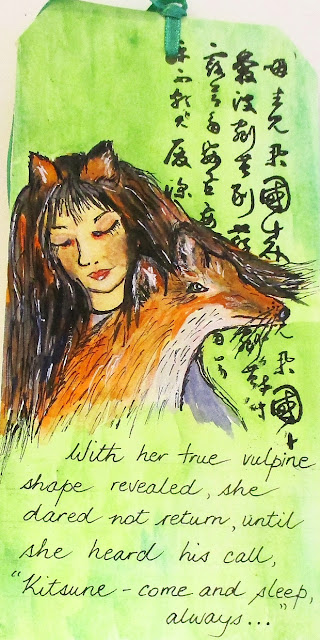 |
| "As the sun sets" - charcoal,ink and watercolour sketch . Copyright Wilma Simmons |
"Trendspotters called it back in February. (2012) More and more, foxes are popping up on the radar as stylish elements in design, outfoxing the omnipresent owl as the It thing in woodland animals. Could foxes be the new owls in hipster home decor?... Remember when every store you went into had some sort of Owl decor? Well bye-bye owls...Foxes are in! Amanda Etty was ahead of the game calling this trend out back in the January 2013 issue of Style At Home , and it's still going strong! ( (http://www.apartmenttherapy.com/trendspotting-are-foxes-the-new-owls-181403 and http://www.styleathome.com/shopping/buying-guides/article/foxes-are-the-new-owls)
 |
| Fox amigurumi - handmade purchase from Renegade Craft Shop, Townsville Queensland 2016 |
I am not sure if anyone has written a PHD thesis on how trends are determined?
However, some reasons for animal trends have been attributed to :
- pop culture The owl certainly didn't lose in the popularity stakes when Hedwig was featured in Harry Potter books and movies? Which animal has been featured in the latest Disney movie?
- current financial situation/lifestyle It has been said that we may have subconsciously turned to the owl, the symbol of wisdom during the Global Financial Crisis
-adaptability of form, offering many depictions and interpretation s appropriate to many different audiences.
 |
| Art Tag "Kitsune" - Copyright Wilma Simmons |
Is it now time for the fox to fade into oblivion too? From what I see, both the owl and fox seem to be still popular design choices and appear destined to be in favour for a lot longer . However, here's a tip - one of the style forecasts for 2017 by Home Beautiful is Botanica, with its rich ripe colours and textures from nature. Perhaps the plant world will take over from the animals as style trendsetters... What's your prediction?
Comments
Post a Comment
Thanks for reading my blog and please share your thoughts about my blog post by leaving a comment.Your comment won't appear immediately as comments are verified before publication in an effort to reduce the amount of spam appearing. Anonymous comments will not be published.